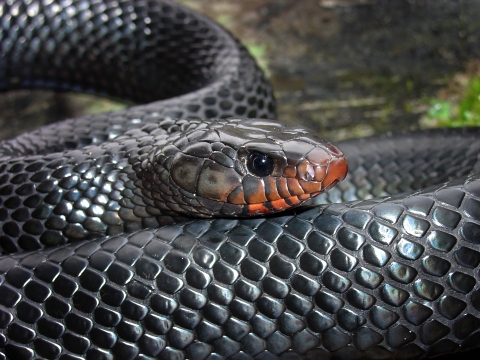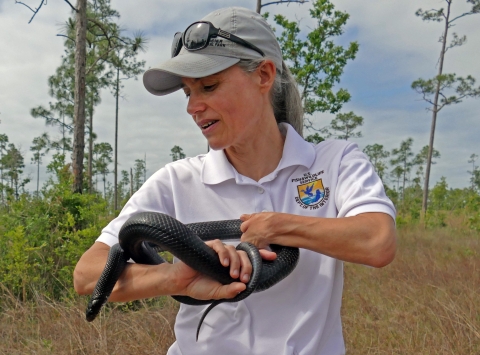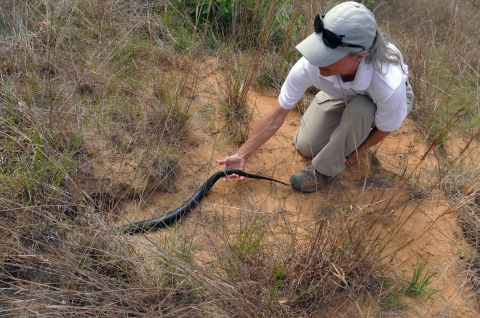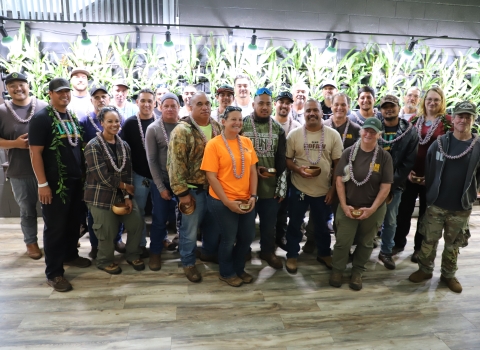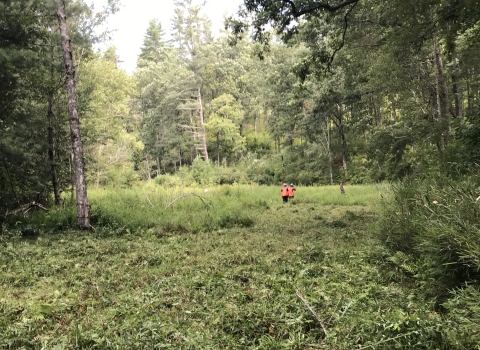He's the emperor of the forest.
The docile and nonvenomous eastern indigo snake is the largest snake in North America, growing up to 9 feet long. Its iridescent blue-black scales glisten in the sunlight; a coral hue tints its chin, throat, and cheeks. The indigo’s diet of animals is varied, but it prefers dining on other snakes.
It is a gentle giant and an apex predator.
The eastern indigo's realm is the longleaf pine forest that once covered Florida, Georgia, Alabama, and Mississippi, where it shelters in gopher tortoise burrows to nest and breed.
The pet trade over-collected them, and hunters killed them by pouring gasoline down gopher tortoise burrows to expel rattlesnakes for roundup festivals. During the depression people killed them when they caught gopher tortoises to eat. As the tortoises and their burrows were destroyed or lost, so were the eastern indigo snakes that depended on them. Development and agriculture consumed 97 percent of the longleaf pine forests in the Southeast. The only indigos left were in peninsular Florida and southeast Georgia.
In 1978 the U.S. Fish and Wildlife Service (Service) listed the eastern indigo snake as threatened under the Endangered Species Act (ESA). One of the early species placed under its protection, the ESA made taking them from the wild illegal without proper permitting. It provided funding through grants to partners and states for land protection and conservation, monitoring and research, outreach and education, and a reintroduction program.
The pet trade is no longer the problem it was, and gopher tortoises and their burrows are protected to varying degrees in southeastern states. But the loss of habitat from development, pesticides, climate change climate change
Climate change includes both global warming driven by human-induced emissions of greenhouse gases and the resulting large-scale shifts in weather patterns. Though there have been previous periods of climatic change, since the mid-20th century humans have had an unprecedented impact on Earth's climate system and caused change on a global scale.
Learn more about climate change , and disease still beleaguer the indigo. The invasive Burmese python spreads a lung parasite that is potentially deadly to them, and an intestinal parasite sickens the snake if it’s otherwise stressed. Indigos are frequently killed crossing roads as they range over hundreds, and even thousands of acres, foraging for food and looking for mates.
A multitude of partners are working to give the snake a fighting chance. Michele Elmore, the Service’s eastern indigo snake recovery coordinator, collaborates with government agencies, academia, and nonprofits to protect remaining populations, restore habitat, and reintroduce the snakes into areas where they have disappeared. “The longleaf pine ecosystem is the path to the snake’s recovery,” she says. Strategies include acquiring conservation easements, managing land for indigo habitat, and protecting gopher tortoises. These efforts help the eastern indigo snake, along with 350-plus species that depend on gopher tortoise burrows.
Elmore says efforts to conserve and restore gopher tortoise populations have provided opportunities to reintroduce eastern indigo snakes back into the Florida Panhandle and South Alabama.
In Florida, the state reports placing nearly 80,000 acres under permanent easements and as of 2022, restored more than 2 million acres of gopher tortoise habitat. Additionally, the state has acquired more than 108,000 acres in conservation easements for eastern indigo snakes, and between 2010-2020, the Florida fire database indicates over 1.5 million acres have been managed by fire to promote ecosystem recovery and health.
Georgia has acquired more than 90,000 acres of conservation easements that protect more than 60 gopher tortoise populations. Land managers there have burned thousands of acres, planted a million longleaf pine trees, and restored up to a thousand acres of native grasses on private and public land, according to Chris Jenkins, CEO of the nonprofit Orianne Society. Heco-chairs the stewardship committee for the Georgia Gopher Tortoise Conservation Initiative, which leads the land restoration efforts in that state. “Snakes are important, they give so much value to entire ecosystems—to turkey, deer, and other wildlife. When we are protecting them and their habitat, we are protecting hiking, hunting, fishing, and even water quality,” says Jenkins.
Increasing and restoring habitat stabilizes remaining populations, while a captive breeding program reintroduces indigos in Alabama and the Florida Panhandle where they have been lost.
The Central Florida Zoo’s Orianne Center for Indigo Conservation breeds and hatches indigos, then transfers them to the Welaka National Fish Hatchery and Zoo Atlanta to be grown, or “headstarted” until they are ready to be released into the wild.
Located on the St. Johns River bank between Jacksonville and Orlando, Fla., the Welaka hatchery cares for up to 30 snakes each year. Their best chance for survival is after they are at least 18 months old, says Tony Brady, the hatchery’s deputy project leader. Brady has been with the Service for 20 years and specializes in mussels and fisheries biology. But in 2017 the hatchery staff modified a building, added a room, and obtained equipment to house young indigos. The first batch of eastern indigo snakes was delivered to the hatchery in 2018.
“We are getting them to a size where they are big enough to survive in the wild. We are giving that kick start to be successful,” Brady says. The snakes are about a foot long when they arrive at Welaka at a year old, grow three to four feet more, and gain two pounds during their six-month stay at the hatchery.
In spring the Welaka staff bundles up the young snakes in pillowcases in preparation for a ride to The Nature Conservancy’s Apalachicola Bluffs and Ravines Preserve in the Florida Panhandle. More than 50 people gathered this year to release 19 snakes. Individuals who were to release a snake included volunteers, biologists, and program managers who care for them, monitor them after release, and help administer the program. Many have been involved in recovering eastern indigo snakes for decades.
Releasing an indigo snake at the Preserve was a special homecoming for Elmore. She began her career there 20 years ago, helping with habitat restoration, prescribed fire, understory restoration, seed collection and distribution, and collecting data. “My internship significantly influenced my career direction and even my personal life. To be able to return to the area over the years in support of eastern indigo snake recovery and witness all the restoration progress is remarkable,” she says.
When it was her turn, Elmore hiked to one of the flagged tortoise burrows tucked between tufts of wire grass. The indigo wrapped itself around Elmore’s arms as she lifted it out of its pillowcase, kneeled to set it on the apron of the burrow, and watched it slide home.
The first snakes were released in Alabama’s Conecuh National Forest in 2010. Since 2017 eastern indigo snakes have been released at The Apalachicola Bluffs and Ravines Preserve. Approximately 350 snakes have been released across both sites since they began.
“This year is special for the Fish and Wildlife Service as our agency is celebrating the 50th anniversary of the Endangered Species Act,” says Elmore. “This eastern indigo snake recovery program is an excellent example of how partnerships like this make species recovery possible and successful. I'm really proud of all we've done together,” she says.
The ESA works. This year marks 50 years of preventing extinction and recovering the wildlife and the habitat they depend on. It has saved 99% of listed species from extinction since it was passed. A listing under the ESA requires the Service to develop and implement a recovery plan. It provides resources and funds. And it raises public awareness, motivating federal agencies, state and local governments, Tribes, conservation organizations, and private citizens to act.
Partners that are working to ensure the success of these efforts include the Florida Fish and Wildlife Conservation Commission, the Alabama Department of Conservation and Natural Resources, the U.S. Forest Service, Department of Defense, Georgia Department of Natural Resources, Auburn University, The Nature Conservancy, Central Florida Zoo's Orianne Center for Indigo Conservation, Zoo Atlanta, Birmingham Zoo, the Orianne Society and others.
“The eastern indigo snake represents the heritage of the Southeast. It is a magnificent and preeminent species and keeps the balance in the ecosystem,” Elmore says. “It would be sad if future generations didn’t have the opportunity to see such a magnificent animal, an important part of the natural and cultural world that is worth protecting.”


